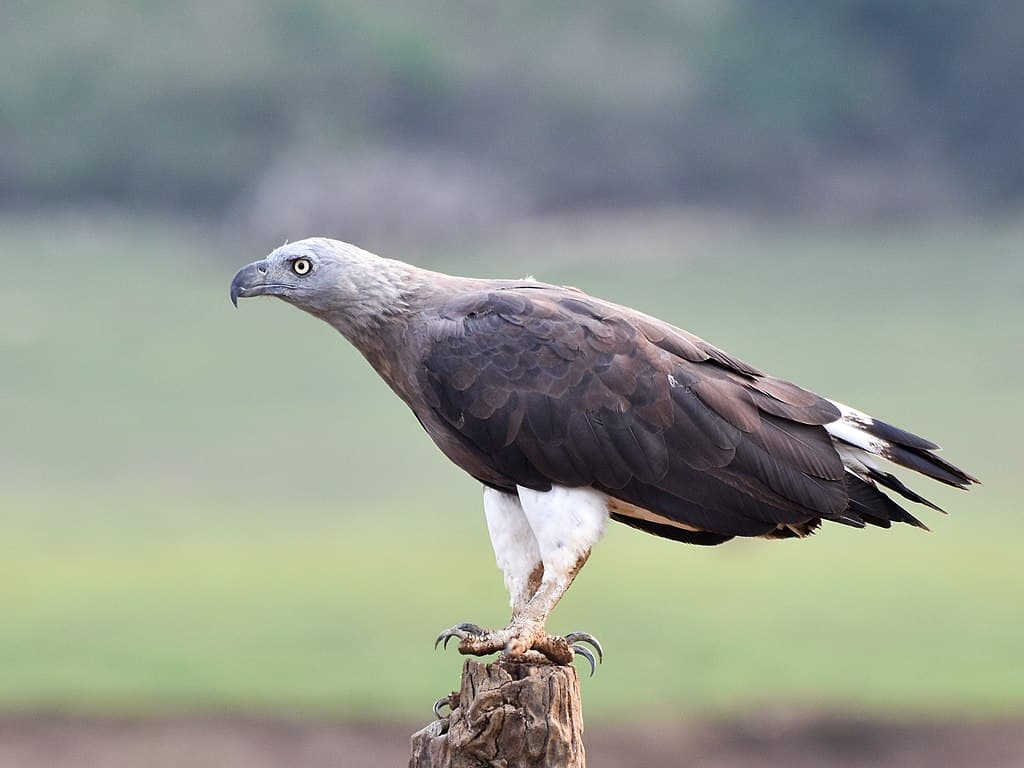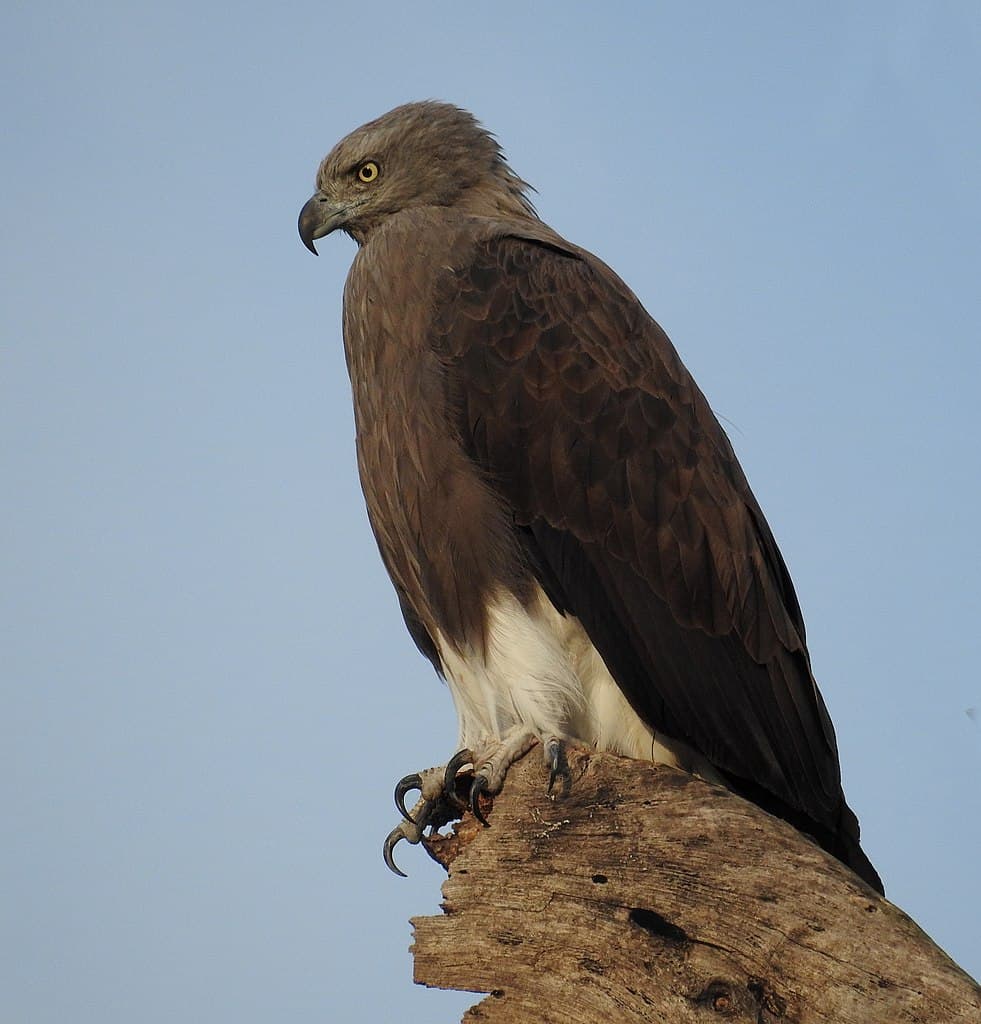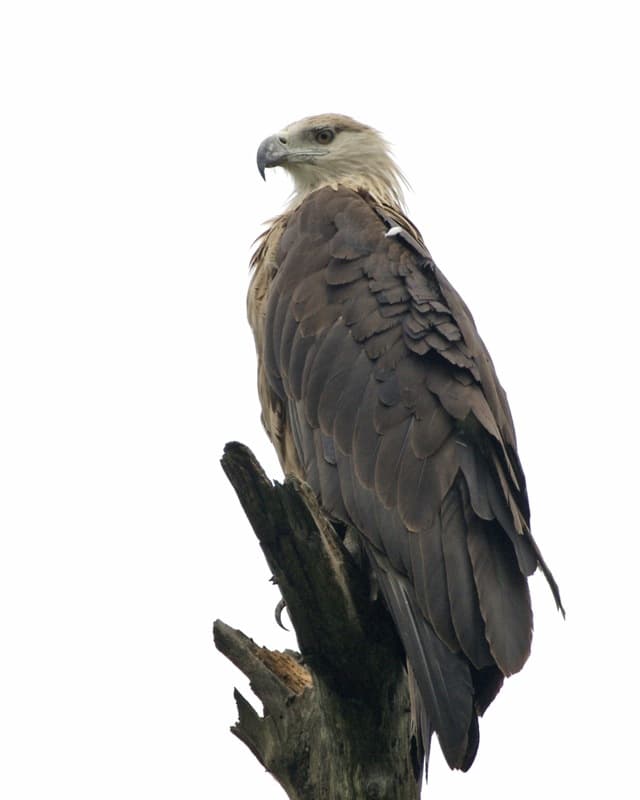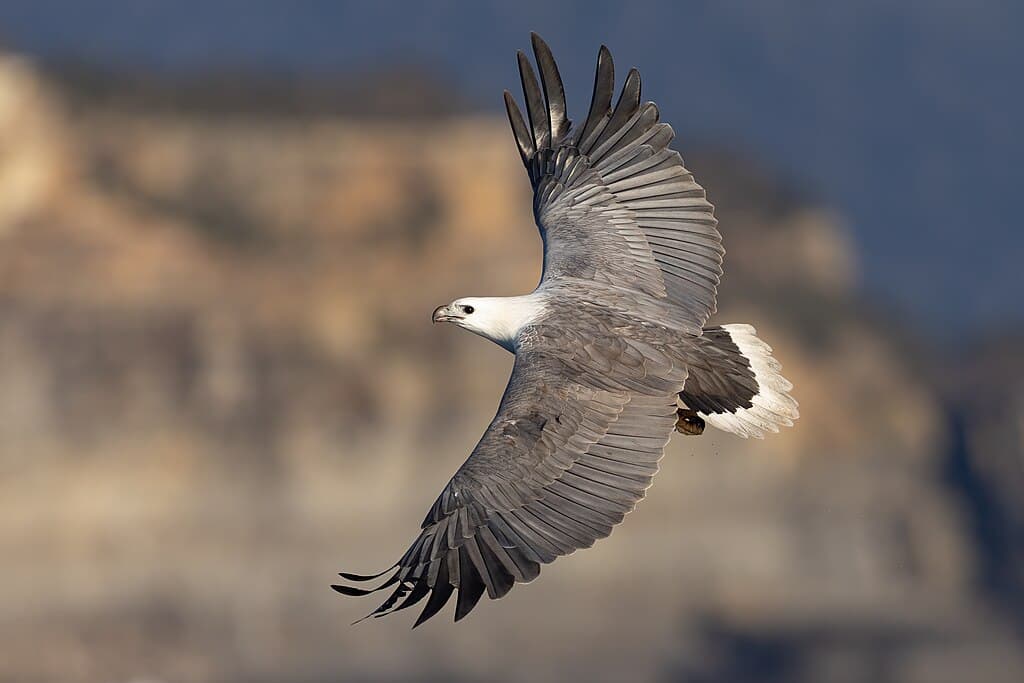Fish eagles or sea eagles are the eagle species that live along big lakes and rivers where they hunt. One fun fact is that not all fish eagles are true eagles. There are 4 fish eagle species that inhabit wetlands in Cambodia, living and feeding on various fish species. Let’s find out what they are with me below.
Grey-Headed Fish Eagle (អកត្រីក្បាលប្រផេះ)

The grey-headed fish eagle is a stocky raptor that grows up to 75 centimeters long. This bird of prey has a dark brown upper body with a small grey head and white legs with unfeathered tarsi. They have large curved talons that allow them to swoop and catch prey with ease. All grey-headed fish eagles are specialist piscivores, preying upon live fish and scavenging dead fish. In case the fish is too big to carry, they will drag it to shore to feast. Sometimes they also feed on reptiles, small birds, and terrestrial birds as well.
This fish eagle species has a wide distribution from India to Southeast Asia ranging in various habitats. Normally, these eagles live in lowland forests and they like to nest close to bodies of water. So they are common near coastal lagoons, estuaries, lagoons, lakes, marshes, reservoirs, slow-moving rivers, streams, and swamps. In Cambodia, they inhabit the Prek Toal protected area along Tonle Sap Lake, the largest freshwater lake in Southeast Asia. Since they are non-migratory, they do not go anywhere else from where they were born at all.
The population of this fish eagle species is declining due to various threats, especially deforestation, habitat loss, and overfishing. Human disturbance, persecution, pollution that results in nesting site loss, and siltation also play an important part in their population decline.
Lesser Fish Eagle (អកត្រីតូច)

Growing up to 64 centimeters tall, a lesser fish eagle is a medium-sized bird of prey that lives in Cambodia. It is grey-brown in color with broad blunt wings at a span of up to 1.2 meters long. This fish eagle has a brown breast with white thighs and belly, and it has a small head and long neck. The lesser fish eagle looks very similar to the grey-headed fish eagles and often gets confused with one another.
Not different from other fish eagles out there, this one also primarily feeds on fish that it snatches from the water. Apart from fish, they also feed on insects, reptiles, and small mammals when available. One of the special features that this fish eagle species has is the strongly curved talons that allow a strong grip. So even if the fish they hunt is slippery, the grip is still firm thanks to this adaptation. More than that, the spicules (tiny projections on the bottom of their feet) along the underside also help aid more grip.
Lesser fish eagles are found in subtropical and tropical regions across Asia. These eagles inhabit various bodies of water such as lakes, rivers, and wetlands as well as along hill streams. Nowadays, their habitats are under threat due to agricultural expansion, deforestation, and urbanization which threaten their population. The lesser fish eagles are now classified as Near Threatened on the IUCN Red List.
Pallas’s Fish Eagle (អកត្រីធំ)

The Pallas’s fish eagle aka the Pallas’s sea eagle is a large sea eagle with an elegant look. This bird of prey can grow up to 85 centimeters with a wingspan of 1.8 to 2.5 meters. It has a light sandy-brown hood and a whitish face with darker brown back rufous and wings. These fish eagles inhabit wetlands, especially large lakes and rivers with tall trees where they can build nests and roost.
Large freshwater fish is the primary diet of this fish eagle species but they also prey on other options. Besides fish, Pallas’s sea eagles also prey upon frogs, insects, reptiles, rodents, snakes, and water birds. Some water birds that they hunt are larger and heavier than them, that right there is some impressive heavy weight-lifting. On one occasion, it was reported that the eagle captured a huge carp and flew with it before losing grip. Hadn’t the gunfire startled the bird, we wouldn’t have known that the carp was twice heavier than the bird itself.
The Pallas’s fish eagle is listed as Endangered on the IUCN Red List, with a global population of less than 2,500 individuals. There are many factors that contribute to their number decline such as direct persecution, habitat degradation, overfishing, and pollution.
White-Bellied Sea Eagle (អកសមុទ្រ)

It is very easy to differentiate the white-bellied sea eagles from the other fish eagle species on the list. This bird of prey has a white head, breast, underwing coverts, and tail with gray upperparts. It can grow up to 90 centimeters long with a wingspan of up to 2.2 meters which is twice its body size. Some white-bellied sea eagles are nomadic while some are not, and the ones that are not are very territorial. As monogamous birds, they form permanent pairs and remain together until one bird dies before the surviving bird seeks a new mate.
Just like the name suggests, the white-bellied sea eagles breed and hunt near coastal water. This sea eagle species is an opportunistic carnivore that both hunts and scavenges. When hunting, it catches a fish by flying low over the water and grasping it in its talons. The favorite meals on the menu are barramundi and catfish but they also feed on needlefish, porcupinefish, and wrasses. Apart from fish, this sea eagle also preyson mammals, snakes, turtles, and waterbirds. If it does not hunt, it consumes the carrion of dead birds, fish, or sheep that it comes across.
Related Post: 3 Vulture Species In Cambodia
